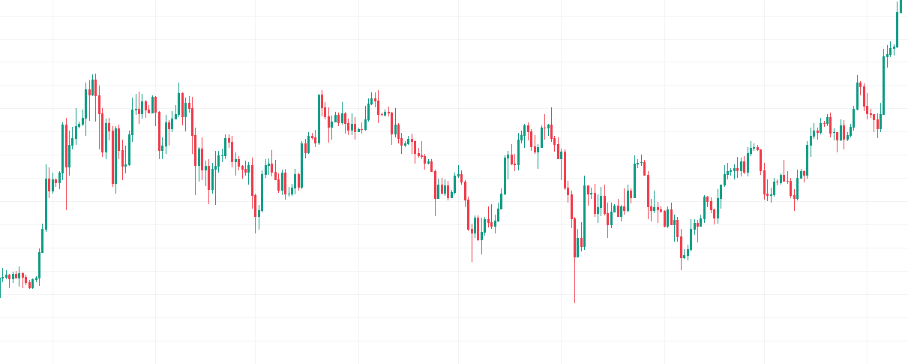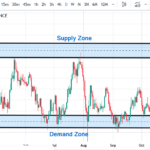How can you use supply and demand zones when trading crypto? This question has been answered for Forex and Options traders and the same concepts apply to more volatile markets like crypto. Therefore, this tutorial is useful irrespective of the financial market you’re conversant with The only difference here, is I’ll be using Bitcoin, Ethereum, Solana, Dogecoin, Injective, and other top cryptos as real examples.
The first step to mastering price action trading with supply and demand is to know what supply and demand in the context of financial markets. If a lot of people are enthusiastic about Bitcoin and are willing to buy it at a certain price (or irrespective of how high its price is), then that’s demand. Alternatively, if more people are less enthusiastic about Bitcoin and wouldn’t mind selling the asset at just about any price, their lack of enthusiasm is what causes a huge sell, which is supply.
One thing that should stand out to you when using supply and demand for trading is the enthusiasm or aggressiveness of both the buyers and sellers.
- The buyers who create demand need to be more aggressive than sellers at a particular time for price to be more in the direction of demand. This direction is upwards as seen in higher highs and higher lows indicating uptrends.
Similarly,
- Sellers who create supply need to be more aggressive than buyers at a zone to cause falling prices and sustain these lower prices. Thus, their strength would be evident in lower highs and lower lows indicative of a bearish trend.
If you understand these basic concepts, let me show you how to identify strong supply and demand zones.
How Does a Zone Differ from a Level?
A zone is different from a level because it is made up of several levels.
A level has a single support or resistance line, whereas a zone has multiple resistance or support lines that create an area of value or interest.
As such, zones are more reliable for entries and exits since they capture more peaks and troughs than levels.
Compare Figure 1 of the SolUSDT chart with Levels and Figure with Zones. Notice how zones capture more peaks and troughs?

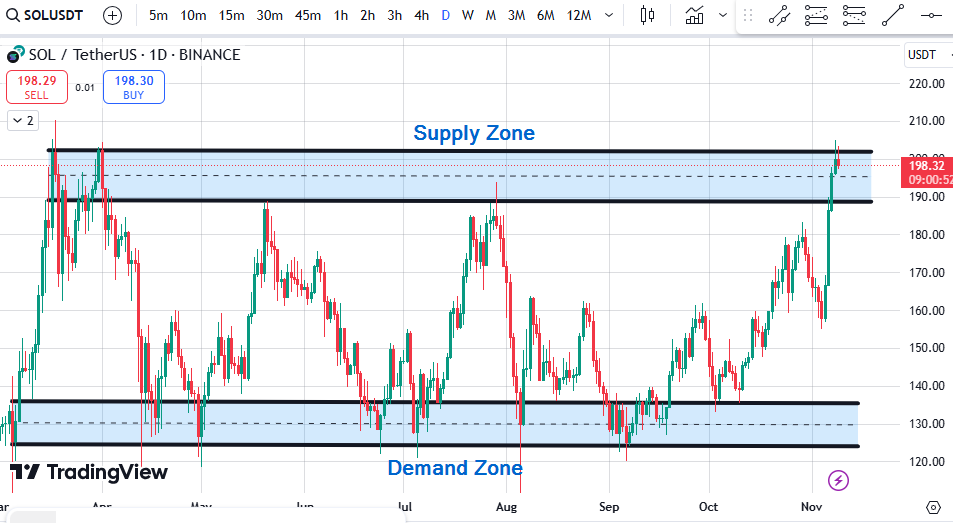
A demand area is where you’d look to make buy entries (spot trading) or take profit on short positions (futures trading) while a supply zone is where you’d make sell entries (spot) or take profit on long entries (futures).
A previous demand zone can become a supply zone and a previous supply zone can also become a demand zone. These are concepts that are peculiar to support and resistance.
How to Identify Strong Supply and Demand Zones
Here are simple ways to identify strong supply and demand zones:
1. Choose a Higher Timeframe
Higher timeframes usually serve as stronger key levels/zones than lower ones.
Therefore, draw your zone on higher timeframes starting from 4 hours.
Usually, the market tends to react more when 4-hour, daily, and weekly candles have closed. Therefore, starting from this medium timeframe would ensure you’re trading in the direction of the enthusiastic market participants. These timeframes are shown in Figure 3.

Remember, you’re drawing a zone, not a level, hence, you’ll need to use channels that can map two levels at a time.
This means that you’ll watch out for potential entries when price has visited the zone.
2. Check Historical Zones or Blocks
So, you’ve chosen a higher timeframe to draw your zone. Look to the left of your chart and also try to spot zones close to the new one you’re trying to draw.
There is a high chance that price would naturally be drawn to these previous zones, hence, you can use them to draw your channel.
Figure 4 shows the peaks and troughs on the left that can guide your drawing of the zone.
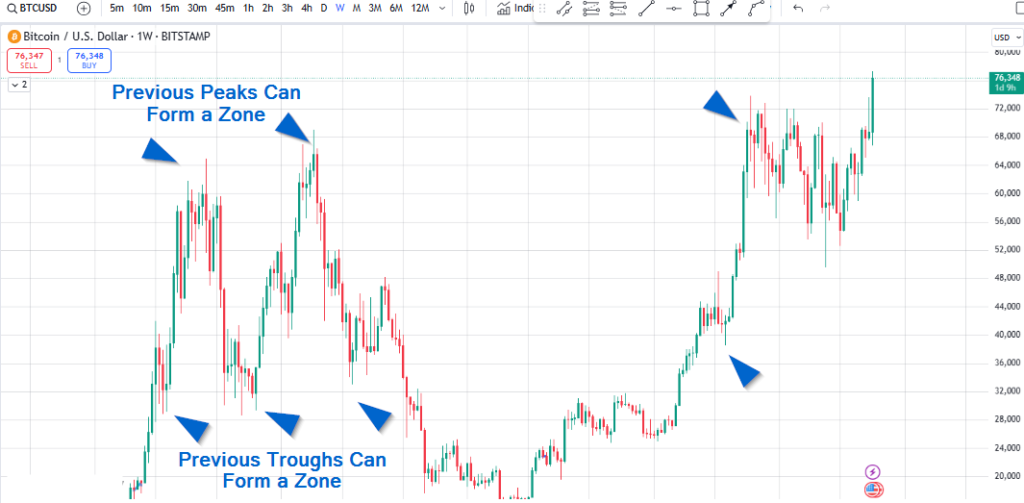
Remember, you can also spot order blocks from these previous zones. Look at the last green candle before the move downwards for a bearish order block. This block can be drawn to serve as a future supply zone where sellers take profit.
Also, the last red candle before the move upwards is a bullish order block. This can be a demand zone that could be retested in future.
In Figure 5, there is a zone created by two order blocks. The first order block is a bearish order block since its a green candle before the move lower, The second order block is a bullish order block. Price retested this block on a wick before a strong rejection of the zone.
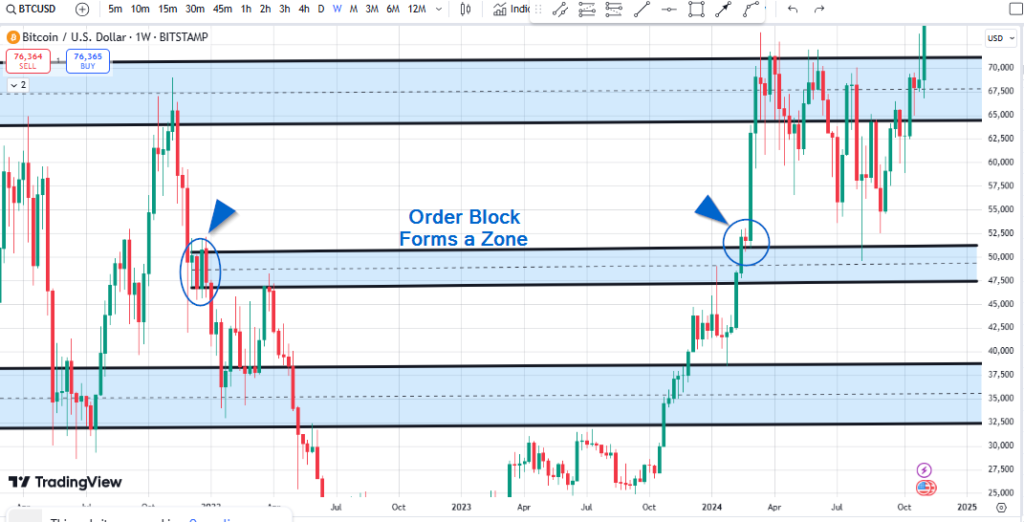
3. Check the Time of Consolidation
You’ve got two tips to work with when identifying supply and demand zones on crypto charts.
The third tip is to study how much time price has spent in the zone.
The longer the time spent in the longer, the more likely the breakout.
This zone is an accumulation zone for a demand area, and a profit taking zone for a supply zone. However, zones can flip especially if the trend is continuing not changing. Price could continue its trend in an uptrend after accumulating in a supply zone.
Accordingly, how many candles can you see around the demand area. Over 50? That’s good! These many candles show the dedication of buyers to maintain the zone.
Are these candles growing smaller? Great! The smaller candles indicate reduced volatility or reduction in selling pressure. More buyers are gradually stepping into the zone and their activity would soon propel price in the upward direction.
Figure 6 is an example with this BitcoinUSDT chart: A supply zone was flipped as demand zone after a breakout. However, price had been consolidating in the supply zone for nine months (February 2024 to November 2024).
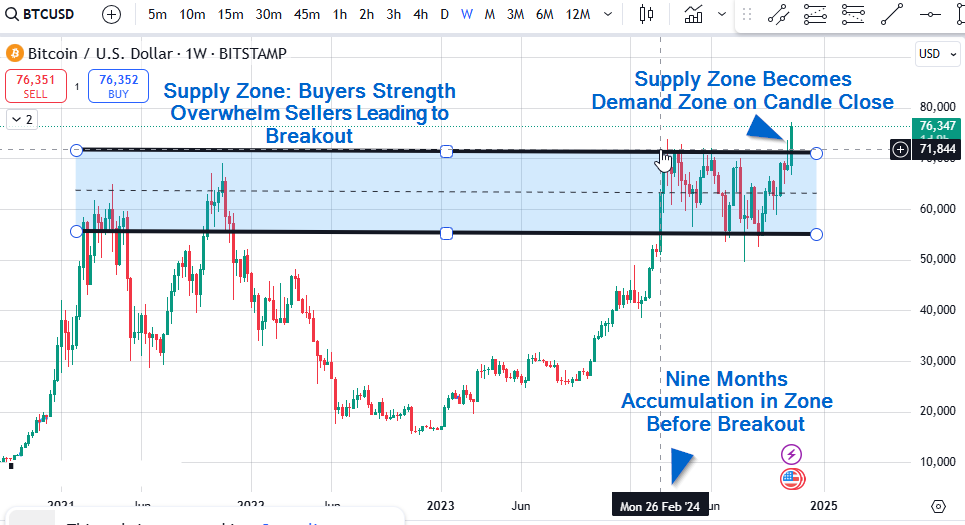
The 4-hour timeframe of the same chart in Figure 7 shows there are over 50 candlesticks in this zone. Thus, a breakout would occur soon.
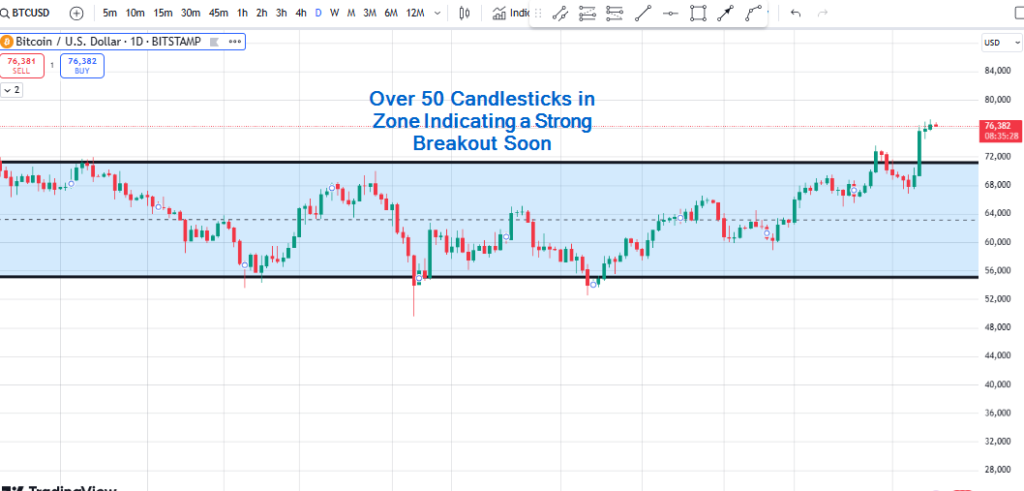
Examples of How to Trade Supply and Demand Zones in Crypto
Here are examples of how to trade supply and demand zones in crypto.
Example 1: Supply and Demand Zones on the DogeUSDT
Based on Figure 8, go to a higher timeframe of your choice and zoom in on your chart.
Zooming in allows you to see more candlesticks, peaks, and troughs.
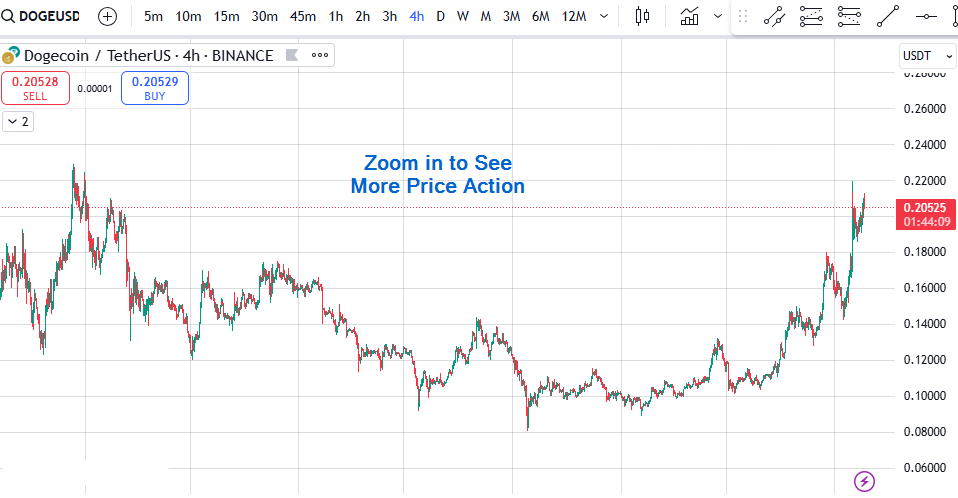
Next, use the Parallel channel tool on trading view to draw your zones as shown in Figure 9. Your channel needs to capture as many peaks and troughs as possible to make it a strong zone.
Try not to spend too much time drawing these levels, if your eyes don’t capture it the first time, then don’t force it. You’ll notice an undrawn zone I’d missed out on my first attempt while drawing. This is also a key zone price that could potentially retest as a demand zone later on,
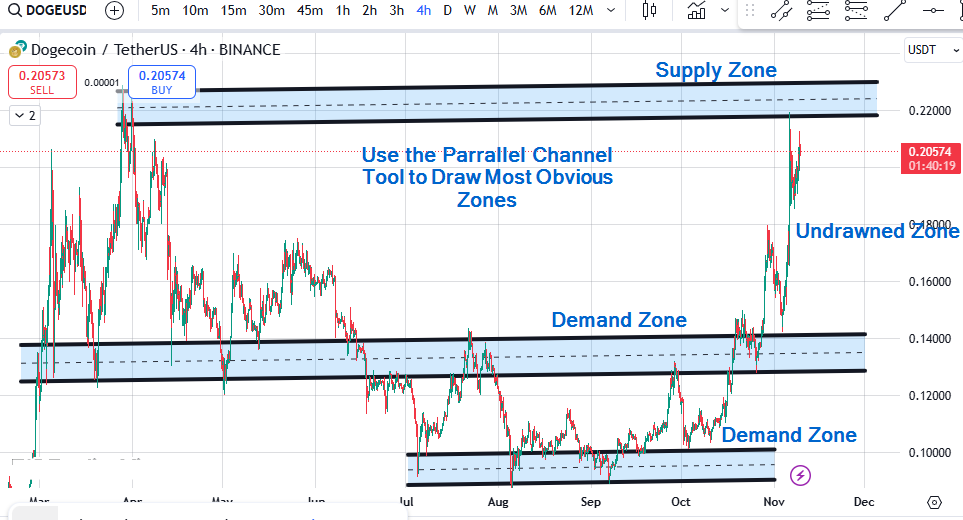
Based on Figure 6, try and bring in some historical context to your current zones by going to a higher timeframe.
Here, I’ve moved to the 1-day timeframe where the lines have been adjusted to capture more regions towards the left. Ideally, you should use a higher timeframe (1 day) before moving to (4 hours) . But then these key levels are still evident on 4H, which is why I used it first. The daily timeframe compresses everything so they’re more evident at a glance.
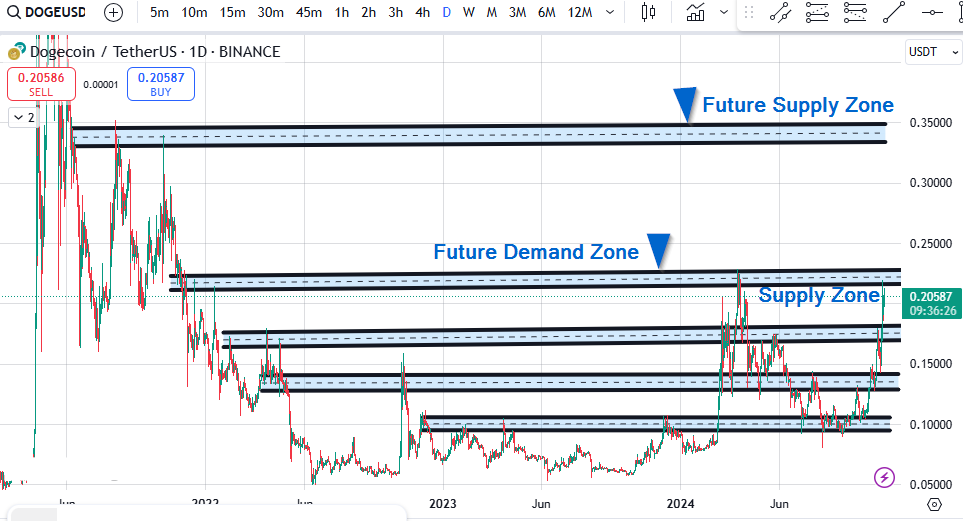
Conclusion
Save this guide as a PDF that will enable you master and trade supply and demand zones profitably. The trading rules in this guide can be used for crypto, Forex, options, Indices, and various other markets. Understanding these zones can help you make more informed trading decisions. First start off with a market you’re conversant with and then diversify to others. If you’re used to scalping, swing trading, or position trading with Bitcoin and alts, these strategies of trading with supply and demand zone will come in handy.

